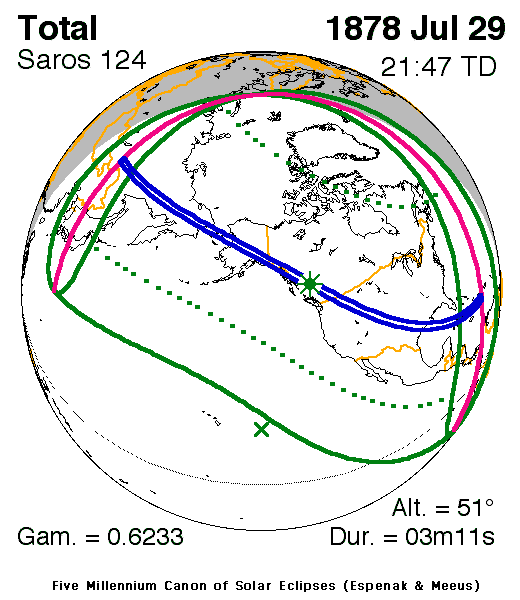An annular solar eclipse occurred on January 22, 1879. A solar eclipse occurs when the Moon passes between Earth and the Sun, thereby totally or partly obscuring the image of the Sun for a viewer on Earth. An annular solar eclipse occurs when the Moon's apparent diameter is smaller than the Sun's, blocking most of the Sun's light and causing the Sun to look like an annulus (ring). An annular eclipse appears as a partial eclipse over a region of the Earth thousands of kilometers wide.The path of totality crossed southern Africa.
| Attributes | Values |
|---|
| rdfs:label
| - Éclipse solaire du 22 janvier 1879 (fr)
- Eclissi solare del 22 gennaio 1879 (it)
- 1879년 1월 22일 일식 (ko)
- Zaćmienie Słońca z 22 stycznia 1879 (pl)
- Solar eclipse of January 22, 1879 (en)
- 1879年1月22日日食 (zh)
|
| rdfs:comment
| - L'éclipse solaire du 22 janvier 1879 est une éclipse solaire annulaire. (fr)
- An annular solar eclipse occurred on January 22, 1879. A solar eclipse occurs when the Moon passes between Earth and the Sun, thereby totally or partly obscuring the image of the Sun for a viewer on Earth. An annular solar eclipse occurs when the Moon's apparent diameter is smaller than the Sun's, blocking most of the Sun's light and causing the Sun to look like an annulus (ring). An annular eclipse appears as a partial eclipse over a region of the Earth thousands of kilometers wide.The path of totality crossed southern Africa. (en)
- L'eclissi solare del 22 gennaio 1879 è un evento astronomico che ha avuto luogo il suddetto giorno, attorno alle ore 11.53 UTC.L'eclissi, di tipo anulare, è stata visibile in alcune parti dell'Africa meridionale. L'eclissi è durata 3 minuti e 3 secondi. (it)
- 1879년 1월 22일 일식은 달이 지구와 태양 사이를 지나면서 태양을 다 가리지 못하고 태양의 가장자리가 고리 모양으로 보이는 금환일식이다. 금환일식은 달의 시직경이 태양의 시직경보다 작아 태양을 다 가리지 못할 때 일어난다. 금환일식은 매우 좁은 지역에서만 관측 가능하며, 대부분의 다른 지역에서는 부분일식으로 관측된다. (ko)
- 1879年1月22日日食为一次在协调世界时1879年1月22日出現的日環食。該次日食食分為0.9700,食甚維持3分3秒。 (zh)
- Zaćmienie Słońca z 22 stycznia 1879 było widoczne jako zaćmienie obrączkowe w Ameryce Południowej, na południowym Atlantyku, w Afryce Południowej i Wschodniej oraz w środkowo-zachodniej części Oceanu Indyjskiego. Zaćmienie częściowe objęło większą część Ameryki Południowej, kontynent afrykański z wyjątkiej Afryki Zachodniej oraz Półwysep Arabski w Azji i Półwysep Antarktyczny na Antarktydzie. Zaćmienie osiągnęło swoje maksimum nad Atlantykiem u wybrzeży dzisiejszej Namibii, gdzie faza centralna trwała 3 minuty i 3 sekundy. (pl)
|
| dcterms:subject
| |
| Wikipage page ID
| |
| Wikipage revision ID
| |
| Link from a Wikipage to another Wikipage
| |
| Link from a Wikipage to an external page
| |
| sameAs
| - Solar eclipse of January 22, 1879
- Solar eclipse of January 22, 1879
- Solar eclipse of January 22, 1879
- Solar eclipse of January 22, 1879
- Solar eclipse of January 22, 1879
- Solar eclipse of January 22, 1879
- Solar eclipse of January 22, 1879
- Solar eclipse of January 22, 1879
- Solar eclipse of January 22, 1879
- Solar eclipse of January 22, 1879
- Solar eclipse of January 22, 1879
|
| dbp:wikiPageUsesTemplate
| |
| has abstract
| - L'éclipse solaire du 22 janvier 1879 est une éclipse solaire annulaire. (fr)
- An annular solar eclipse occurred on January 22, 1879. A solar eclipse occurs when the Moon passes between Earth and the Sun, thereby totally or partly obscuring the image of the Sun for a viewer on Earth. An annular solar eclipse occurs when the Moon's apparent diameter is smaller than the Sun's, blocking most of the Sun's light and causing the Sun to look like an annulus (ring). An annular eclipse appears as a partial eclipse over a region of the Earth thousands of kilometers wide.The path of totality crossed southern Africa. (en)
- L'eclissi solare del 22 gennaio 1879 è un evento astronomico che ha avuto luogo il suddetto giorno, attorno alle ore 11.53 UTC.L'eclissi, di tipo anulare, è stata visibile in alcune parti dell'Africa meridionale. L'eclissi è durata 3 minuti e 3 secondi. (it)
- 1879년 1월 22일 일식은 달이 지구와 태양 사이를 지나면서 태양을 다 가리지 못하고 태양의 가장자리가 고리 모양으로 보이는 금환일식이다. 금환일식은 달의 시직경이 태양의 시직경보다 작아 태양을 다 가리지 못할 때 일어난다. 금환일식은 매우 좁은 지역에서만 관측 가능하며, 대부분의 다른 지역에서는 부분일식으로 관측된다. (ko)
- Zaćmienie Słońca z 22 stycznia 1879 było widoczne jako zaćmienie obrączkowe w Ameryce Południowej, na południowym Atlantyku, w Afryce Południowej i Wschodniej oraz w środkowo-zachodniej części Oceanu Indyjskiego. Zaćmienie częściowe objęło większą część Ameryki Południowej, kontynent afrykański z wyjątkiej Afryki Zachodniej oraz Półwysep Arabski w Azji i Półwysep Antarktyczny na Antarktydzie. Zaćmienie osiągnęło swoje maksimum nad Atlantykiem u wybrzeży dzisiejszej Namibii, gdzie faza centralna trwała 3 minuty i 3 sekundy. W czasie zaćmienia rozegrała się bitwa pod Isandlwana, w której starły się oddziały Zulusów i Brytyjczyków. W miejscu bitwy Księżyc przesłonił około 55% tarczy Słońca. (pl)
- 1879年1月22日日食为一次在协调世界时1879年1月22日出現的日環食。該次日食食分為0.9700,食甚維持3分3秒。 (zh)
|
| prov:wasDerivedFrom
| |
| page length (characters) of wiki page
| |
| foaf:isPrimaryTopicOf
| |
| is Link from a Wikipage to another Wikipage
of | |
| is Wikipage redirect
of | |
| is foaf:primaryTopic
of | |


![[RDF Data]](/fct/images/sw-rdf-blue.png)



![[RDF Data]](/fct/images/sw-rdf-blue.png)



![[cxml]](/fct/images/cxml_doc.png)
![[csv]](/fct/images/csv_doc.png)
![[text]](/fct/images/ntriples_doc.png)
![[turtle]](/fct/images/n3turtle_doc.png)
![[ld+json]](/fct/images/jsonld_doc.png)
![[rdf+json]](/fct/images/json_doc.png)
![[rdf+xml]](/fct/images/xml_doc.png)
![[atom+xml]](/fct/images/atom_doc.png)
![[html]](/fct/images/html_doc.png)